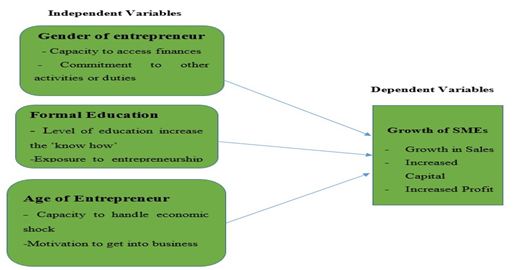Significance of Entrepreneurs’ Demographic Factors on the Growth of SMEs in the Clothing Industry
DOI:
https://doi.org/10.5281/zenodo.10814212Keywords:
smes, entrepreneur demographics, clothing industry, zambiaAbstract
This study addresses the challenges faced by small and medium enterprises (SMEs) in the clothing industry in Lusaka town of Zambia. The study focuses on external factors and entrepreneurs' demographic characteristics. While previous research explored external challenges, the study aims to fill the gap by investigating how entrepreneurs' age, gender, and education influence SME growth in the clothing business sector. The objectives of the study were to; determine the relationship between the age of entrepreneurs and the growth of their SMEs; determine the relationship between the gender of the entrepreneurs and the growth of their SMEs and to establish the extent to which the entrepreneurs’ level of education influence the growth of their SMEs. The research adopts a positivism research philosophy and employs a quantitative research approach, utilizing an explanatory research design. The study is conducted in the Central Business District (CBD) of Lusaka town, given its prominence in SMEs. The target population comprises SMEs in the clothing business, and the sample size is determined using a stratified random sampling method. Data collection involves structured questionnaires, and data analysis is performed using the Statistical Package for Social Sciences (SPSS) version 22. Descriptive statistics, Chi-square tests, t-tests, and multiple regression analyses are employed to examine relationships between demographic factors and SME growth. The findings reveal a positive relationship between the age of entrepreneurs and SME growth, indicating that older entrepreneurs have a more significant influence on the growth of SMEs. However, the gender of entrepreneurs does not show a significant relationship with SME growth, challenging traditional beliefs. Surprisingly, the study finds a negative relationship between the level of education and SME growth, contradicting some existing literature. Based on these insights, recommendations are made, including initiating entrepreneurial training programs, improving access to financial resources, promoting gender inclusivity, and implementing policy interventions. The study emphasizes the importance of continuous research to monitor evolving dynamics and inform adaptive strategies for sustained SME growth.
Downloads
References
Ali, H., Hao, U., & Aijuan, C. (2020). Innovation capabilities and small and medium enterprises’ performance: An exploratory study. Journal of Asian Finance, Economics, and Business, 7(10), 959–968.
Birley, S., & Westhead, P. (2013). Growth and performance contrasts between types of small firms. Strategic Management Journal, 11(1), 535-557.
Escalera-Chavez, M., Kramer, C.A.R., Cordova-Rangel, A., & Moreno-Garcia, E. (2015). Empirical evidence on the locus of control among owner and manager and its relation to successful firms. Journal of Emerging Trends in Economic and Management-Sciences, 6(3), 177–184.
Islam, A., Khan, M.A., Obaidullah, A.M., & Alam, M.S. (2011). Effect of entrepreneur and firm characteristics on the business success of s.
Mall and medium enterprises (SMEs) in Bangladesh. International Journal of Business and Management, 6(3).
Korunka, C., Kessler, A., Frank, H., & Lueger, M. (2010). Personal characteristics, resources, and the environment as predictors of business survival. Journal of Occupational and Organizational Psychology, 83(4), 1025-1051.
Kristiansen, S., & Indarti, N. (2011). Entrepreneurial intention among Indonesian and Norwegian students. Journal of Enterprising Culture, 12(1).
Mabenge, B. K., Ngorora-Madzimure, G. P. K.., & Makanyeza, C. (2022). Dimensions of innovation and their effects on the performance of small and medium enterprises: The moderating role of firm’s age and size. Journal of Small Business & Entrepreneurship, 34(6), 684-708.
Muzata, S. (2024). Motivations for entrepreneurship: New evidence from tertiary-level educated sub-saharan african women. Journal of African Business, 25(1), 37-67.
Nuwagaba, A. (2015). Enterprises (SMEs) in Zambia. International Journal of Economics, Finance and Management, 4(4).
Oguntona, A.O., & Aigbavboa O.C. (2018). Factors influencing the growth of small, medium and micro enterprises in the Zambian construction industry. Sustainable Human Settlement and Construction Research Centre, 9(12), 889-996.
Pramono, R., Sondakh, L.W., Bernarto, I., Juliana, J., & Purwanto, A. (2020). Determinants of the small and medium enterprises progress: A case study of sms entrepreneurs in Manado, Indonesia. Journal of Asian Finance, Economics and Business, 8(1), 881–889.
Woldie, A., Leighton, P., & Adesua, A. (2008). Factors influencing small and medium enterprises (smes): An exploratory study of owner/manager and firm characteristics. Banks and Bank Systems, 3(3).

Downloads
Published
How to Cite
Issue
Section
License
Copyright (c) 2024 Mukoba M. Mbulakulima, Bupe G. Mwanza

This work is licensed under a Creative Commons Attribution 4.0 International License.
Research Articles in 'Management Journal for Advanced Research' are Open Access articles published under the Creative Commons CC BY License Creative Commons Attribution 4.0 International License http://creativecommons.org/licenses/by/4.0/. This license allows you to share – copy and redistribute the material in any medium or format. Adapt – remix, transform, and build upon the material for any purpose, even commercially.









